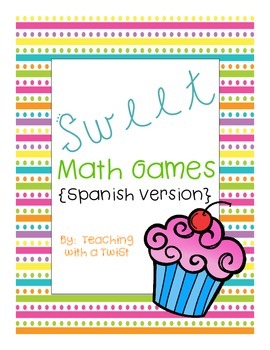Sweet 1st grade math games {for all year!} in Spanish
Teaching with a TwiSt
1.2k Followers
Grade Levels
K - 2nd
Subjects
Standards
CCSS1.NBT.B.2
CCSS1.NBT.B.2a
CCSS1.NBT.B.2b
CCSS1.NBT.B.2c
CCSS1.NBT.B.3
Formats Included
- PDF
Teaching with a TwiSt
1.2k Followers
Description
*This is the Spanish version of this product*
This product includes a math game to address many TEKS and common core standards taught in first grade during the course of the year. {11 games total!} The games would be great for centers, guided math, or small groups. Overall, little prep is involved :) {Mostly printing, laminating, and a little cutting}
You will need a few materials such as wooden craft sticks, avery labels, dice, game pieces, beans, paper clips, brads, cubes, plastic or real coins, and yarn or play dough.
The games cover the following topics:
-Order Numbers from 50 to 100 {a version of Go Fish}
-Add to make 10 {Roll & Cover}
-Addition to 20 {Bump}
-Find the Missing Part {First to the top wins}
-Subtract from 20 {Game board}
-Place Value to 120 {Spin & Win}
-Identify coins by value {Roll & Take/ Give}
-Name 2 Dimensional Shapes {A version of pictionary}
-Name 3 Dimensional Shapes {A version of bingo}
-Identify halves and fourths {Trash or Treasure}
-Read time to the hour and half hour {A version of battleship}
I hope you enjoy this product! Please leave feedback and email me with specific questions or requests at linsayhumphrey@yahoo.com. Thank you very much :)
*This product was created by Teaching with a TwiSt*
This product includes a math game to address many TEKS and common core standards taught in first grade during the course of the year. {11 games total!} The games would be great for centers, guided math, or small groups. Overall, little prep is involved :) {Mostly printing, laminating, and a little cutting}
You will need a few materials such as wooden craft sticks, avery labels, dice, game pieces, beans, paper clips, brads, cubes, plastic or real coins, and yarn or play dough.
The games cover the following topics:
-Order Numbers from 50 to 100 {a version of Go Fish}
-Add to make 10 {Roll & Cover}
-Addition to 20 {Bump}
-Find the Missing Part {First to the top wins}
-Subtract from 20 {Game board}
-Place Value to 120 {Spin & Win}
-Identify coins by value {Roll & Take/ Give}
-Name 2 Dimensional Shapes {A version of pictionary}
-Name 3 Dimensional Shapes {A version of bingo}
-Identify halves and fourths {Trash or Treasure}
-Read time to the hour and half hour {A version of battleship}
I hope you enjoy this product! Please leave feedback and email me with specific questions or requests at linsayhumphrey@yahoo.com. Thank you very much :)
*This product was created by Teaching with a TwiSt*
Total Pages
Answer Key
N/A
Teaching Duration
Lifelong tool
Report this resource to TPT
Reported resources will be reviewed by our team. Report this resource to let us know if this resource violates TPT’s content guidelines.
Standards
to see state-specific standards (only available in the US).
CCSS1.NBT.B.2
Understand that the two digits of a two-digit number represent amounts of tens and ones. Understand the following as special cases:
CCSS1.NBT.B.2a
10 can be thought of as a bundle of ten ones - called a “ten.”
CCSS1.NBT.B.2b
The numbers from 11 to 19 are composed of a ten and one, two, three, four, five, six, seven, eight, or nine ones.
CCSS1.NBT.B.2c
The numbers 10, 20, 30, 40, 50, 60, 70, 80, 90 refer to one, two, three, four, five, six, seven, eight, or nine tens (and 0 ones).
CCSS1.NBT.B.3
Compare two two-digit numbers based on meanings of the tens and ones digits, recording the results of comparisons with the symbols >, =, and <.





